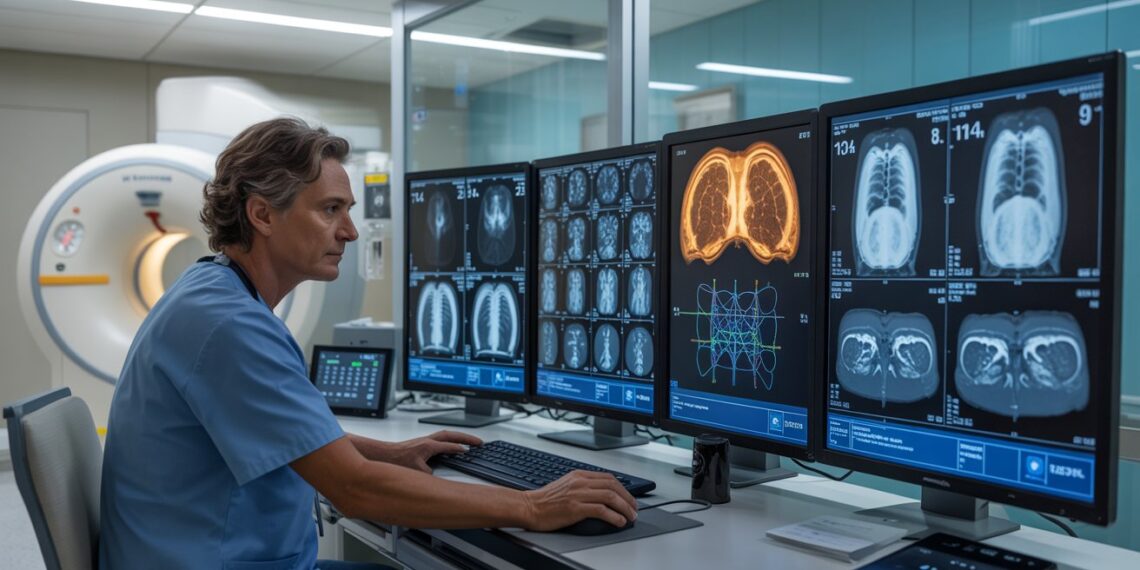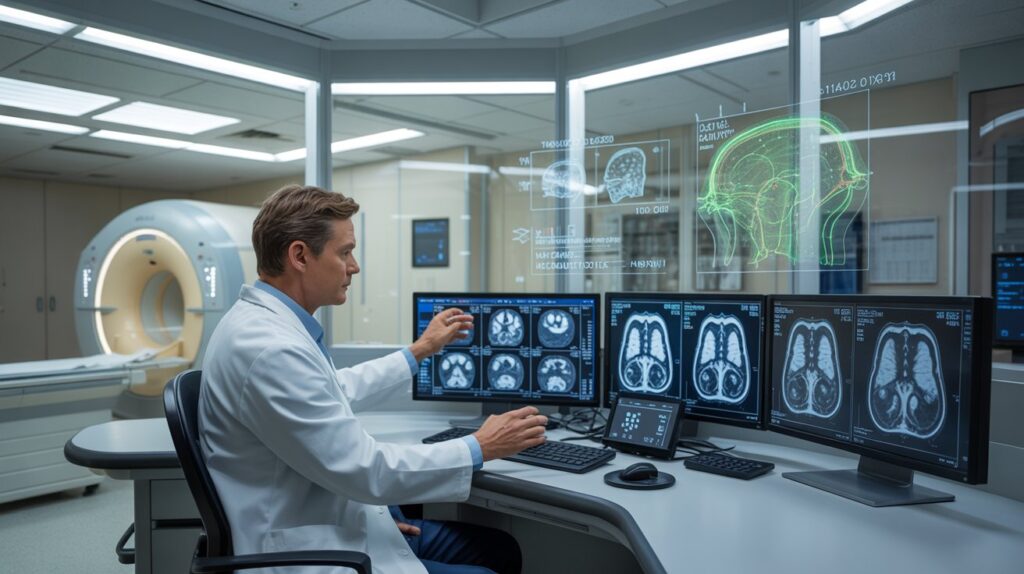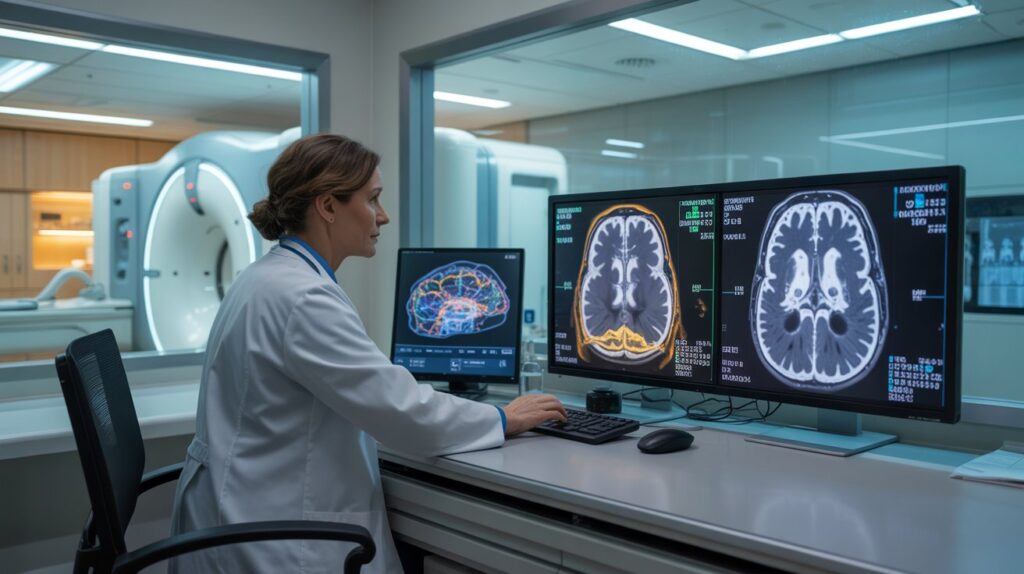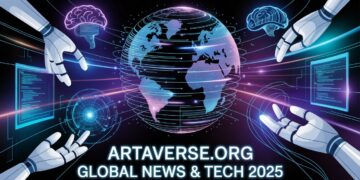Radiology is the backbone of modern medicine. From X-rays and CT scans to MRIs and ultrasounds, diagnostic imaging allows clinicians to detect, monitor, and treat countless conditions. Yet, with the growing volume of scans and a global shortage of radiologists, healthcare systems face mounting pressure to interpret images faster and more accurately.
That’s where AI in Radiology and Diagnostics is stepping in — transforming medical imaging from a manual, time-consuming process into a more efficient, data-driven discipline. Artificial Intelligence, powered by machine learning and deep neural networks, is helping radiologists detect diseases earlier, reduce human error, and optimize workflows across hospitals worldwide.
In this article, we’ll explore how AI is reshaping radiology and diagnostics, its current capabilities, limitations, ethical concerns, and what the next decade might look like for this critical intersection of healthcare and technology.
Understanding the Role of AI in Radiology and Diagnostics
Artificial Intelligence (AI) refers to computer systems that can perform tasks typically requiring human intelligence — such as recognizing patterns, learning from data, and making predictions. In radiology, AI models are trained using thousands or even millions of medical images to recognize visual patterns associated with disease.
For example, AI can highlight suspicious lesions on a mammogram, detect a pulmonary nodule on a CT scan, or even predict stroke risk from brain images. Rather than replacing radiologists, AI acts as an assistant — enhancing diagnostic precision and allowing specialists to focus on complex interpretations and patient care.
The Technology Behind AI in Radiology
1. Machine Learning and Deep Learning
Machine learning algorithms allow computers to learn from labeled data. In radiology, this might involve feeding the AI system thousands of chest X-rays labeled as “normal” or “pneumonia.” Over time, the algorithm learns the distinguishing visual features between the two.
Deep learning — a subset of machine learning — uses artificial neural networks to process images in layers, mimicking how the human brain works. Convolutional Neural Networks (CNNs) are particularly suited for analyzing imaging data such as CT or MRI scans.
2. Natural Language Processing (NLP)
NLP helps AI interpret and generate human language, enabling systems to read radiology reports, extract key information, and even draft preliminary interpretations. NLP tools are now being integrated into Picture Archiving and Communication Systems (PACS) to streamline documentation.
3. Computer Vision
Computer vision allows AI systems to “see” and interpret visual information from images and videos. In diagnostics, this means automatically identifying abnormalities, segmenting organs, or comparing current and previous scans to detect subtle changes.
Key Applications of AI in Radiology and Diagnostics
1. Disease Detection and Early Diagnosis
AI excels in identifying early signs of disease that may be invisible to the human eye.
-
Breast Cancer: AI algorithms have demonstrated performance comparable to expert radiologists in mammogram interpretation, with fewer false positives.
-
Lung Disease: Deep-learning systems detect nodules or lung cancer from CT scans with remarkable accuracy.
-
Neurology: AI-assisted MRI analysis can identify early patterns of Alzheimer’s disease or detect microbleeds after trauma.
By integrating AI, radiologists can diagnose faster and improve the likelihood of early treatment, potentially saving lives.
2. Workflow Optimization
AI is streamlining every step of the radiology workflow — from scheduling scans to report generation. Automated triage systems prioritize critical cases (e.g., suspected stroke or hemorrhage) for faster interpretation. Image reconstruction algorithms also reduce scan times, improving patient throughput.
Some hospitals report up to 30% faster turnaround times after implementing AI-enabled systems. The result is greater efficiency, reduced radiologist burnout, and improved patient satisfaction.
3. Quantitative Imaging and Precision Medicine
AI can extract quantitative data from medical images — known as “radiomics.” These data points can reveal subtle patterns and correlations linked to disease progression, treatment response, or genetic markers.
For example, in oncology, AI can assess tumor size, shape, and texture to predict how a patient might respond to chemotherapy. Such insights are central to precision medicine, where treatments are tailored to individual patients.
4. AI-Powered Image Reconstruction
AI doesn’t just analyze images — it can help create them. Advanced reconstruction algorithms use deep learning to produce high-quality scans from lower doses of radiation or shorter MRI times.
This means safer, faster imaging for patients and reduced costs for healthcare providers.
5. Integration with Other Medical Data
Modern AI platforms don’t operate in isolation. They combine imaging data with patient history, genetic information, and lab results to provide a more comprehensive diagnostic picture. This multi-modal approach supports clinical decision-making and improves diagnostic confidence.
The Benefits of AI in Radiology and Diagnostics
-
Enhanced Accuracy: AI helps detect anomalies that even experienced professionals might overlook.
-
Increased Efficiency: Automating repetitive tasks like segmentation, measurement, and reporting saves time.
-
Early Detection: Early identification of diseases leads to better outcomes and lower healthcare costs.
-
Reduced Workload: AI tools act as intelligent assistants, allowing radiologists to focus on patient care.
-
Data-Driven Insights: AI provides analytics and predictive modeling that support evidence-based medicine.
Challenges and Limitations
While the promise of AI is immense, several barriers remain:
1. Data Quality and Bias
AI systems are only as good as the data they’re trained on. If training datasets lack diversity or contain biases, the models may perform poorly on certain populations.
2. Interpretability (“Black Box” Problem)
Deep learning models often produce accurate results without clear explanations. This lack of transparency makes it hard for clinicians to trust AI decisions fully.
3. Regulatory and Legal Issues
AI tools in healthcare require approval from regulatory bodies like the FDA or EMA. Ensuring safety, reliability, and accountability remains 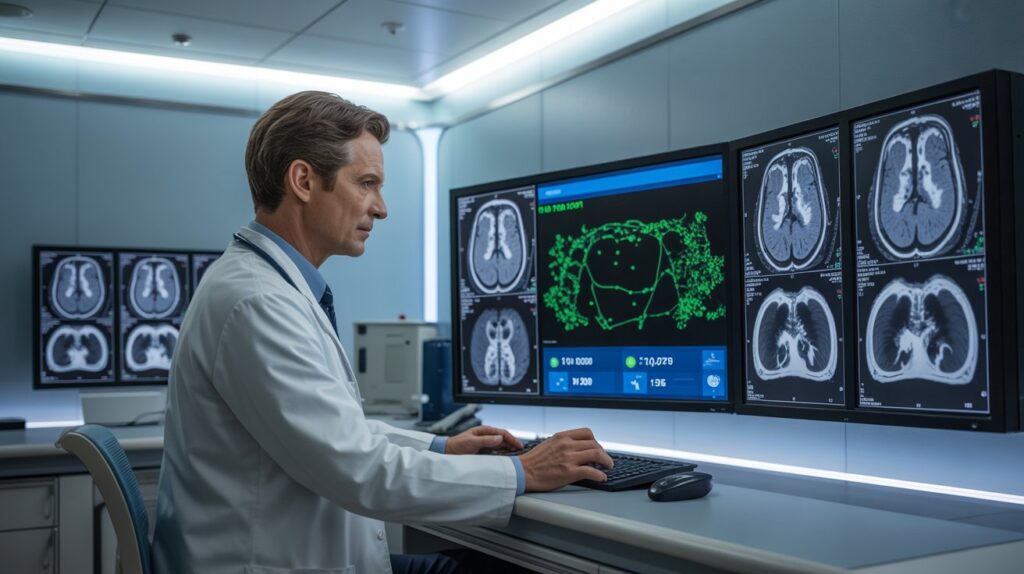
4. Integration with Clinical Workflow
AI adoption requires compatibility with existing hospital systems and buy-in from staff. Without seamless integration, even the best algorithms can fail to add value.
5. Ethical and Privacy Concerns
AI systems process large volumes of sensitive patient data. Maintaining confidentiality and preventing misuse are ethical imperatives in every implementation.
The Evolving Role of the Radiologist
Contrary to fears of automation, AI is augmenting, not replacing, human radiologists. The radiologist of the future will combine medical expertise with data literacy — interpreting AI outputs, validating findings, and communicating results to patients.
AI will handle the mechanical tasks, but human judgment will remain vital for context, empathy, and complex decision-making. The synergy between humans and machines will define the next era of diagnostic excellence.
Global Adoption and Market Trends
The global AI in radiology and diagnostics market is expanding rapidly, projected to exceed $10 billion by 2030. North America and Europe currently lead adoption, but Asia-Pacific regions are catching up fast due to increased healthcare investments and government initiatives.
Hospitals, startups, and tech giants are all investing heavily in AI-driven imaging. Companies like Siemens Healthineers, GE Healthcare, and Aidoc are developing FDA-cleared solutions already deployed in clinical environments.
Ethical Use and Data Governance
For AI to thrive responsibly in medicine, ethics must take center stage. Institutions are now creating frameworks for:
-
Transparent model development
-
Informed patient consent for data use
-
Bias testing and mitigation
-
Continuous post-deployment monitoring
Strong data governance ensures that AI benefits all patients equitably, without reinforcing systemic inequalities.
Future of AI in Radiology and Diagnostics
The next decade will see even deeper integration of AI across diagnostic workflows. Emerging trends include:
-
Federated learning: Training AI models across multiple hospitals without sharing sensitive patient data.
-
Explainable AI (XAI): Systems that show radiologists why a decision was made, boosting trust and adoption.
-
Real-time diagnostics: Instant AI feedback during scans for faster clinical action.
-
Predictive analytics: Anticipating disease before symptoms appear through continuous imaging and data analysis.
Ultimately, AI will evolve from an assistive tool to a fully collaborative partner in patient care.
Frequently Asked Questions
What is AI in Radiology and Diagnostics?
It refers to the application of artificial intelligence — including machine learning and deep learning — to interpret medical images, detect diseases, and optimize radiology workflows.
Will AI replace radiologists?
No. AI supports radiologists by automating routine tasks and improving diagnostic accuracy, but human expertise remains essential for context and clinical decisions.
How accurate are AI diagnostic systems?
Studies show AI can match or even exceed human accuracy in specific tasks (like detecting lung nodules), but it works best as a supplement to radiologist expertise.
Is AI safe and regulated in healthcare?
Yes, but it must pass rigorous clinical validation and regulatory approvals before use. Continuous monitoring is essential to ensure safety and performance.
What are the main benefits of AI for hospitals?
Faster reporting, improved accuracy, better patient outcomes, and more efficient use of resources.
Conclusion
AI in Radiology and Diagnostics is no longer a futuristic concept — it’s an evolving reality reshaping medical imaging today. By combining human intuition with machine precision, AI helps healthcare professionals diagnose earlier, treat smarter, and work more efficiently.
While challenges around bias, ethics, and integration persist, the progress is undeniable. The radiology departments that embrace AI today are setting the standard for a smarter, safer, and more personalized future of healthcare.
In this new era, radiologists and AI will not compete — they will collaborate to redefine the very nature of medical insight.


